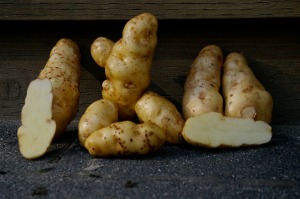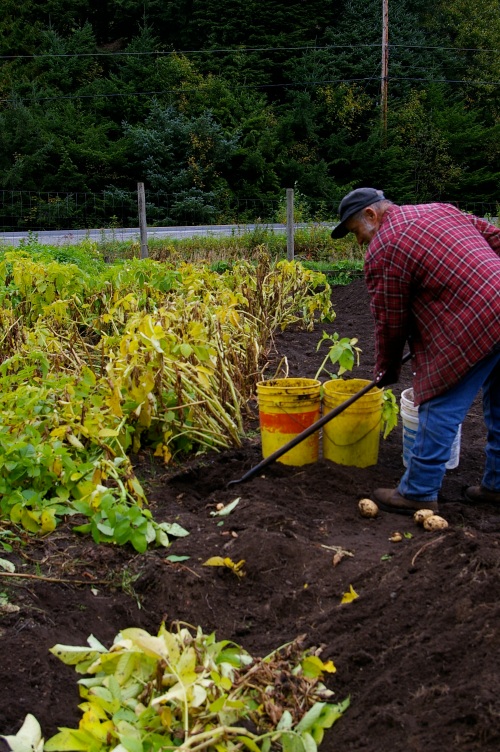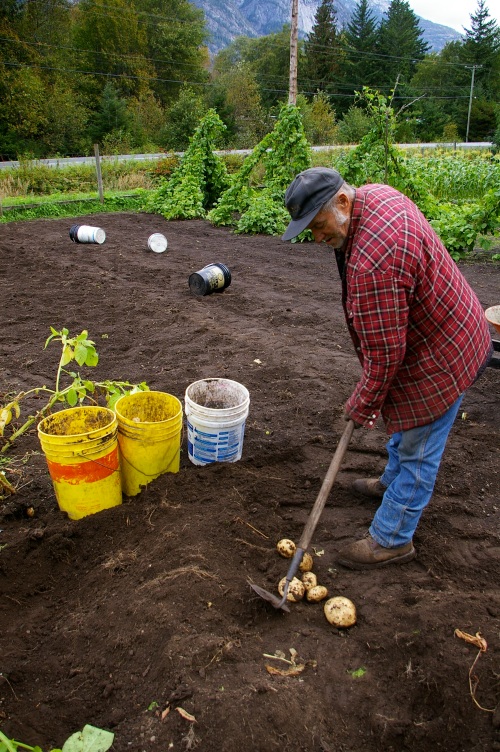I’ve recently been involved in a discussion with the BC Food Systems Network about the relationship between bears and food security. In terms of food security, this issue is an extremely important one for anyone living where large predators exist. I plan to write about it over several posts in order to dispel some common misconceptions about the human-predator relationship in terms of food security, and to propose some practical solutions.
Please feel free to voice your opinions in the comments section. I welcome the input, as it gives us all a chance to talk about this important issue. Your comments also provide me with food for thought, and the chance to develop my ideas.
How to make bears and fruit trees get along
A member of the BC Food Systems Network recently wrote about their community’s experience with the Conservation Service. According to this source, the COs in their area, instead of dealing effectively with any nuisance bears, are threatening people with fines if they don’t cut down their fruit and nut trees. While outraged with this Ministry’s attitude, I’m not surprised by it. Here in the Bella Coola Valley, too, people are being advised to cut down their fruit trees by the Conservation Service, instead of being offered support, protection (part of their motto!), and–oh, yes–conservation.
False belief #1: The ‘remove the attractant’ theory
In terms of food security, the idea that we must ‘remove all attractants’ to prevent bears from entering our communities is a dangerous line of thinking (particularly in light of our economic times). The logic may sound reasonable when you are living in the city and dealing with a bear in your garbage can. However, it is not consistent with the goals of food security, because in rural BC there is no limit to the list of attractants. Therefore, we cannot have food security in our communities and be consistent with these Ministry guidelines.
Most specifically, and to put it simply: if we ascribe to the notion that humans can control bear behaviour by ‘removing the attractants’, then we cannot raise food. Fruit trees, berry bushes, carrots, and parsley all attract grizzly bears. Chickens, ducks, sheep, goats, and rabbits, all attract grizzly bears. The duck feed, the goat feed, and the chickens’ corn all attract grizzly bears. Fields of corn and oats attract bears. Beehives attract bears. (Many of the above also attract a host of other predators that threaten our food security, such as eagles, foxes, wolves, cougars, mice, owls, hawks, martin, weevils, and so on.)
If we are to be consistent with the ‘remove the attractant’ theory, then the next ‘logical’ step is to pass public policy laws that forbid people from raising their own food. In order to ‘remove all the attractants’ we will have to cut down all the fruit trees, plant no vegetable or herb gardens, and get rid of all the feed and grain for our agricultural animals–chickens (see Needless Suffering), ducks, geese, goats, pigs, turkeys, sheep, and so on–lest we be seen to be ‘baiting’ the bears. Instead, maybe we could free range our agricultural animals? No. To be consistent with the ‘non-attractant theory’ we must leave it to the corporate agricultural producers who can afford (both ethically and financially) to keep animals indoors, behind Fort Knox type fenced areas, or on feedlots.
New Jersey Example
The idea of removing the attractants simply doesn’t work. This line of thinking got the state of New Jersey into its conundrum with their bears. They have gone a long way down this path, having made city wide efforts of removing the ‘attractants’ from their city streets and neighbourhoods. They have made huge efforts to limit the times in which garbage could be out on the street for collection, and even made centralized collection stations. Nevertheless, despite the fact they have removed all the so called ‘attractants’, bears have NOT stopped coming into people’s yards. Now accustomed to viewing human settlements as good food sources, bears are now entering houses. We should learn from their experience instead of continuing down the same path.
If we are going to have, and support, real food security in our province, we have to change the way we look at this problem. If not, then we will eventually lose the right to keep fruit trees, grow gardens, and raise animals for food. The evidence of this is revealed in the current attitude of British Columbia’s Conservation Service Officers.
Living under siege
The idea that humans are responsible to not ‘attract’ the bears is ridiculous. Humans have always grown gardens, had fruit trees, and domesticated animals in places where large predators roamed. Since humans have been on earth they have been in direct competition with other large predators for their food (livelihood) and, by shooting, trapping, snaring, or other aggressive measures, have trained these wild animals not to intrude into their human settlements. Until very recently, we have known and understood our relationship with the natural world; part of our role was teaching wildlife what is appropriate behaviour. We have lost that understanding now that most of us buy food from the grocery store, agricultural production is out of sight and out of mind, and the closest we get to a grizzly bear is by watching the Discovery Channel,
It is time to re-educate ourselves to re-educate the bears. Even the Conservation Officer Service acknowledges that humans can ‘teach bears bad habits’, so why not teach them some good ones?
To view the series of posts on this topic, see:

 Vancouver’s most famous Environmentalist, David Suzuki, is running a contest for pesticide free gardeners this summer. They say you don’t have to be a master gardener to play a starring role in the
Vancouver’s most famous Environmentalist, David Suzuki, is running a contest for pesticide free gardeners this summer. They say you don’t have to be a master gardener to play a starring role in the 
















